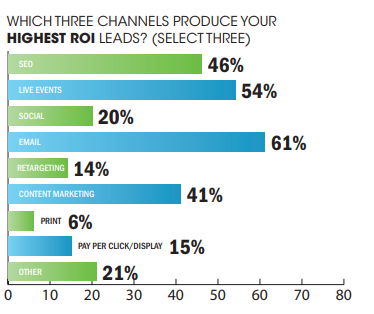Fast-paced coffee-fueled conversations, promotional pens that you’ll never use, and a legion of lanyards attached to lurching attendees who’ve overindulged the night before...
Jokes aside...
I love conferences for lead generation because you get to learn emerging industry information, develop meaningful relationships, and generate high-quality leads.
Given the opportunity to attend, I don’t easily turn down the conferences.
For me, conference lead generation is where it’s at. I’ve met great people and generated thousands from B2B sales, all thanks to the social connections I’ve made at conferences.
Ahead, I’ll show you how to do the same.
Note: Want to know if the prospects you are emailing are making it back to your website? Leadfeeder will tell you. Try it free, we'll show you what companies visited your website in the last 30 days in minutes.
Why you should focus on conferences to generate leads
According to research by Chief Marketer, more than 50 percent of B2B marketers rank in-person events, like conferences, as the best source for high-quality leads.

But what makes conferences so effective, and why should you consider using them to support lead generation?
Conferences are primed for personalization
There’s an army of competitors with similar services and me-too content all vying for the same commodity as you: attention from leads.
That’s why personalization is an undisputed part of B2B sales. It spells the difference between being ignored, or resonating with prospects and fueling your pipeline with leads.
If you’ve done your homework beforehand, conferences and in-person meetups are the ultimate forms of personalization.
This is because you’re there in the flesh, in-person; and that’s hard to ignore. As Gaetano DiNardi, Director of Marketing for Sales Hacker put it:
“I think the beauty of the sales conference, or any conference really, is that you can avoid all that funnel stuff, and you can basically prospect who’s going to be at the conference ahead of time, you can scope out who is potentially gonna be a good lead for you.”
In-person events and conferences attract decision-makers
According to Bizabbo, 84% of leadership execs (Vice President and C-Suite) believe that in-person events are critical to their company’s success.
Even if decision-makers are not present themselves, they’re likely to send a trusted colleague.
At a conference, this gives you instant, in-person access to decision-makers and provides a common ground for productive networking and business opportunities.
Conferences attendees hover at the discovery stage

As little as 4% of web visitors are ready to buy.
A web visitor can be a bored student, a nosy competitor, or a tire-kicker.
This means that on the web, it takes a lot of hard-earned inbound traffic to generate sales as most visitors are not qualified leads.
Conference attendees, however, have made a serious investment learning about a specific subject or painful problem; they qualify themselves.
This signals that they’re hovering at the research/discovery stage of the buyer journey.
A stage where 71 percent of buyers welcome vendors to interact with them.
The 5-step plan to generate leads from conferences
From local meetups, to lead generation & SaaS conferences with 10,000+ attendees bustling through acres of exhibit space, I’ve attended my fair share of conferences.
I’ve learned that typical “networky” tactics like handing out stress balls and business cards are great for tired hands, but not so great at generating B2B leads from conferences.
Below, you’ll find the step-by-step process I use to ensure every conference I attend generates leads:
Step 1: Set your success criteria
What’s a successful conference lead generation campaign for your business?
Unless you’re a widely recognized company, spreading brand awareness isn’t exactly going to fill your pipeline with leads.
That’s why defining the realistic outcomes of your in-person activities is critical.
For example, if you’re a SaaS company, like us, the end goal might be to:
Generate 50 trial sign-ups.
Or set 6 appointments with potential integration partners.
If you’re a marketing agency, however, your outcomes will probably look like this:
Send 25 proposals to qualified leads.
Get 100 download requests for a case study.
Step 2: Reference attendees with your ICP and buyer personas
After you’ve set lead generation goals for the conference, it’s time to identify the prospects you’ll target.
With thousands of potential leads, your ideal customer profile (ICP) and buyer persona are your best friends.
Use them to filter the list of attendees down to those who match your ICP and personas.
While you’re working the list, pay special attention to the following attributes:
Annual revenue.
Industry. (Case studies and content that shows how you’ve helped other companies in your lead’s industry are gold.)
Geography. (If you’re close to, or traveling near a prospect’s HQ, you have a better chance of securing a meeting by making it easier for them to say yes.)
Then, create a custom contact list — use a scraping tool to speed this up — for the next step.
If there’s no master list of attendees available, reference the past year’s attendees list against a lead’s social media accounts.
Step 3: Set appointments with qualified attendees
With your list ready, send personalized messages to each prospect.
If you have a mutual connection, ask them for an introduction, first.
This is an often overlooked part of generating leads from conferences.
Trust me, the last thing you want is to be that guy/gal frantically searching for last-second leads and unfortunately, scaring people away in the process.
Time taken to craft the right message is time well spent.
You’ll fill your schedule with high-ROI appointments and organize powerful post or mid-event meetups.
Event marketing company Cience found this out when one email template was 18x more effective than the other — with just a few minor tweaks. Can you guess which one it is?
Conference lead generation template A:

Or conference lead generation template B:

The correct answer: A.
To get more leads to agree to an appointment:
Use a snappy, conference-specific subject line.
Conclude with a strong CTA. Specificity is the key to getting prospects to agree to an appointment.
Keep it short and establish rapport.
If you don’t have a mutual connection to introduce you, let them know that you’re also attending the event and explain why you’re emailing them.
After prospects have agreed to meet you, schedule reminders leading up to the conference, and double-check they’ll meet you a day before the event.
Step 4: Break your prospects’ guessing machines
Did you know that there’s an informational curse we all suffer from?
Because we’re all constantly bombarded with repetitive information, our brains constantly guess what’s coming next.
When we guess right, we zone out.
In their book Made to Stick, researchers Chip and Dan Heath revealed that the only way to get people to not only notice, but also remember you, is to break this guessing cycle.
Yes, to actually develop a connection with key decision-makers, you have to do something different from everybody else.
At conferences, you’ve probably noticed that branded Swag bags are a way that sponsoring companies to try to stand out.
While Swag bags can work, they’re expensive and not as effective at larger conferences.
My personal (and inexpensive) favorite is to schedule mini-events or micro meetups with prospects.
Reaching out to the prospects who’ve agreed to meet you, or those you’ve met at the conference, simply invite them to an opportunity to unwind after an intense day.
Given the rigorous pace of conferences, you'll be surprised at the number of people willing to let their hair down at a restaurant or swing clubs at mini-golf.
To make sure your meetup is actually memorable:
Scour the local area beforehand for highly-reviewed, low-commitment outings or eateries.
Get people to sign up in advance, if you can. Manage the meetup through a Whatsapp group.
Make sure it doesn’t clash with the event. Opt for a time after the event, or during the after-hours of the conference.
Take pics while you’re having fun. Pictures will come in handy as they’ll create common ground for potential follow-ups.
Step 5: Follow up fast
While the previous step will help prospects remember you, a conference is still a whirlwind of information and non-stop networking.
By the time it’s over, even responsive prospects will experience difficulty recalling who they spoke to and what they discussed.
And quite often, they want to continue the conversation with you, but they lose your card or mistyped your contact details.
That’s why they follow up is so important. Here’s how to make your follow up more successful
Show that you know
Share an experience you shared, or even better, include the picture you took at step 4 in the email.
Communicate value
Remind them how your product/service will benefit them and you’ll recapture their interest.
Follow up fast
58% of B2B companies fail to followup leads at all. Most people suck at following up leads from conferences, they either give up too early or just don’t follow up at all.
That’s a great opportunity for you to strike while the iron is hot and close a deal.
Conferences are a medium for social lead generation
It’s hard to break through the noise in B2B sales. Buyers do their homework, review multiple vendors, and want the perfect solution for them.
For companies looking to generate leads at conferences, that’s good news!
Because with a bit of preparation and a spark of genuine connection, you avoid anonymous “online ping-pong” exchanges.
Instead, you jump the queue and land personal connections with key decision-makers who want the solution you can offer.
Note: Want to know if the prospects you are emailing are making it back to your website? Leadfeeder will tell you. Try it free, we'll show you what companies visited your website in the last 30 days in minutes.
Now that you're here
Leadfeeder is a tool that shows you companies that visit your website. Leadfeeder generates new leads, offers insight on your customers and can help you increase your marketing ROI.
If you liked this blog post, you'll probably love Leadfeeder, too.
Sign up






